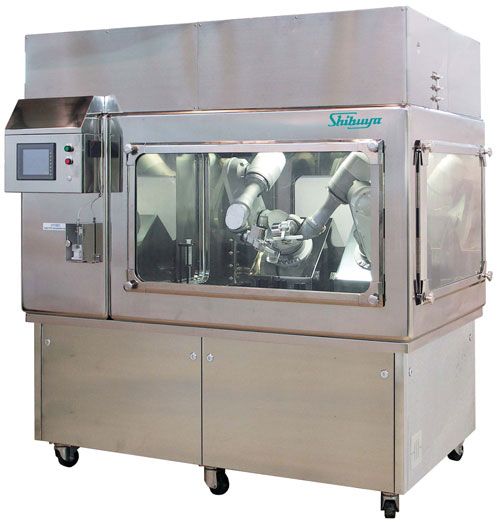Teaching a New Robot Old Tricks
Equipment and Processing Report
Automation has been part of pharmaceutical processing for some time, but robotics have not yet found wide acceptance among drugmakers.
Automation has been part of pharmaceutical processing for some time, but robotics have not yet found wide acceptance among drugmakers. Recent concerns about quality control, efficiency, and cost reduction should spur the industry to reexamine the potential advantages of robotics. Robots can be particularly helpful in sterile-manufacturing applications, which are important at a time of strong demand for cytotoxic and biopharmaceutical drugs.
Shibuya Kogyo’s (Ishikawa, Japan) CellPRO system could replace human operators in processes that carry the risk of contaminating sensitive products or harming personnel. The system includes two M-430iA/2PV robotic arms created by FANUC Robotics America (Detroit) with Shibuya’s technical support. The arms are installed in Shibuya’s isolator. The robots are designed to work in International Organization for Standardization (ISO) 5 environments and do not contribute a significant amount of particulates under typical working conditions. The arms move on six axes and carry a maximum payload of 2 kg. Design features such as enclosed electric cables, triple seals, and a lack of retention areas help resist bacterial growth on the machines and reduce the potential for contamination. The robots have the International Electrotechnical Commission’s International Protection rating of 67 and are designed to withstand decontamination with vapor-phase hydrogen peroxide.
The FANUC robots can be controlled in several ways, including manually or with a standard programmable logic control. Shibuya’s Manipen controller enables personnel to operate the robots from a separate room or another facility. Jim Akers, president of Akers Kennedy and Associates and a member of Pharmaceutical Technology’s editorial advisory board, likens the Manipen to a more sophisticated version of the Nintendo Wii controller. The Manipen works through push-button and accelerometer operation and vibrates when a robot contacts a solid object, similar to the way a Wii controller functions. A user can step on a foot pedal to move the robots’ grippers into a horizontal position to pick objects up easily. The robots also can be programmed to operate automatically.

The CellPRO system’s control software has the ability to record human operators’ movements, save them as a set of instructions, and repeat them exactly. Using this feature, personnel can train the robots to perform specific tasks. After several days of practice, an operator can learn to control the robot arms well, and the arms’ trainability makes control relatively straightforward.
Manufacturers could incorporate Shibuya’s system into many pharmaceutical applications. The CellPRO system has potential to increase operator safety by compounding potent drugs, manufacturing radiopharmaceuticals, or handling cytotoxic ingredients. The robots also could help to reduce contamination risk in aseptic environments by replacing humans in cell-culture, sterility-testing, and aseptic-processing applications. The CellPRO system is appropriate for research applications, packaging, and small-scale clinical manufacturing as well, says Akers.
As it has for other industries, robotics can bring speed, repeatability, and flexibility to pharmaceutical operations. The CellPRO system is one example of the technological advances that could improve the safety, quality, and efficiency of small- and large-molecule production. As software and robots become more sophisticated, drugmakers have less reason to shy from adapting them to their processes. Robotics could become an integral part of the industry’s strategy for the 21st century.
Drug Solutions Podcast: A Closer Look at mRNA in Oncology and Vaccines
April 30th 2024In this episode fo the Drug Solutions Podcast, etherna’s vice-president of Technology and Innovation, Stefaan De Koker, discusses the merits and challenges of using mRNA as the foundation for therapeutics in oncology as well as for vaccines.